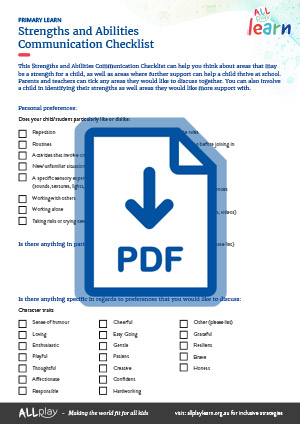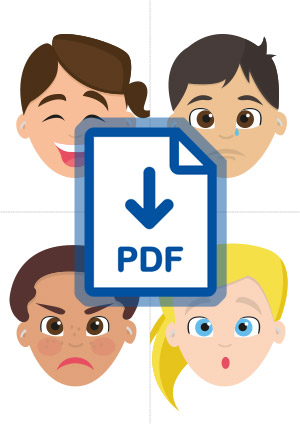
Cerebral Palsy
On this page:

About cerebral palsy
Cerebral palsy is a disorder that affects the way a person moves. Cerebral palsy occurs when there is damage to the brain when it is developing, and it affects a child’s ability to control their muscles. It is the most common form of physical disability in childhood.
A child with cerebral palsy may face challenges with muscle weakness and stiffness. Some children might have trouble with slowness or shakiness, and they may not be able to control their movement. Balance, coordination and walking can also be difficult. Cerebral palsy can affect different parts of the body. Some children may have trouble with motor control on one side of their body, some may have challenges with both sides, and some may have challenges that affect only the lower part of their body.
About one third of children with cerebral palsy also have epilepsy, which means that they have recurring seizures. There are different types of epilepsy, and they affect children in different ways. Some children may stare blankly or look as if they are daydreaming during a seizure. For some children, a seizure may involve stiffness or jerking movements. Some children will benefit from medication, which means that seizures may be rare. If a child in your group has epilepsy, ask the parents and child’s support team about how you can recognise a seizure and what to do.

Strengths
What might be some strengths?
- Children with cerebral palsy will have a range of different strengths depending on how they are affected. For example, some children will have unaffected speech and thinking skills.
Where might you provide support?
- Children with cerebral palsy will differ in how much their movement is impacted. Some children will walk independently, while others will use mobility aids (e.g. a walking frame or a wheelchair). Some children may have trouble controlling their muscle movements, which can impact their coordination.
- If muscles in the face, mouth, and throat are affected by cerebral palsy, children can experience challenges with talking, eating and drinking. They may find speech challenging, which means they might use different ways of communicating (e.g. using pictures or gestures with their hands or head), or they might need more time to communicate.
- Children with cerebral palsy may experience chronic or recurring pain. This may affect their behaviour. They may become less motivated to join in.
- Some children may have trouble with writing, drawing, and other craft activities.

Evidence-based strategies
Work collaboratively
Consider how you give instructions and communicate
Adapt activities to be as inclusive as possible
Create plenty of space for movement
- Work with parents. Talk with the child and their family about the child’s unique strengths, preferences, and abilities. This includes areas they need extra help in and the best methods of communication.
- Build a relationship with the support team. There may be various health professionals involved in supporting the child (e.g. occupational therapist, physiotherapist, speech pathologist). Working together can lead to a shared understanding of the child, their goals, and strengths based strategies that are consistent across other environments like home and the community.
- Set joint play and learning outcomes. Work with the child’s parents as well as the professionals supporting the child to set some specific and measurable outcomes. Aim to set outcomes that focus on the child’s strengths and are challenging enough to support learning and social development.
- Model learning and social skills. When teaching new skills, it can be helpful if an educator or another child demonstrates the skill. This may need to be repeated lots of times.
- Use multiple modes of communication. Visual aids such as picture cards in addition to verbal cues and instruction and hands on demonstrations can be helpful.
- Plan ahead. You may need to prepare equipment or adjustments for supporting a child’s full participation before starting an activity.
- You may need to rearrange the physical space and check that pathways are free. This may mean checking if pathways are wide enough for a child to easily navigate and that there are no loose objects on the floor.

Best practice tips
Allow plenty of time for activities and transitions
Create a predictable environment
Provide clear rules and expectations
Provide plenty of encouragement
Acknowledge efforts using interests
Promote self-determination
- Promote self-determination. Empower and teach children to make simple choices, set goals, be independent, and develop problem-solving abilities. Use technology as needed. For example, technology can be used by children who communicate non-verbally to indicate preference.

Early years learning and development outcomes
Outcome 1: Children have a strong sense of identity
Outcome 2: Children are connected with and contribute to their world
Outcome 3: Children have a strong sense of wellbeing
Outcome 4: Children are confident and involved learners
Outcome 5: Children are effective communicators
- Early childhood educators can help support children’s learning and participation by creating a secure and positive social environment where they can build relationships with educators and other children
- Encourage adults to move away from the child when the child does not need their help. This can help a child become more independent. It may also encourage a sense of belonging to the group and increase social interactions with other children.
- Provide plenty of opportunities for the child to interact with other children and participate in activities
- Children with cerebral palsy may need help with interacting with others or building relationships
- Encourage full participation in play and learning activities. This helps children form positive relationships, and allows them to learn new concepts, ideas and behaviours together.
- Consider including role playing and other play-based learning activities
- Encourage participation in pretend play as this will provide chances for the child to express their emotions
- Children with cerebral palsy may benefit from being surrounded by various textual and visual material and objects. This might include posters on the walls, labels on objects and a variety of story/picture books.
- Let the child choose their preferred toys and materials and provide them with plenty of time to explore them. Some play materials may need to be modified. For example, velcro added to toys can help the child hold on to them.
- Consider using multiple methods to promote learning. This could be visual, vocal, or movement related including hands on demonstrations. See adapt activities to be as inclusive as possible.
- A child with cerebral palsy may need extra support with communication and might use pictures, gestures or technology such as tablets and speech devices. Encourage the child to use technology that best supports their play and learning, and that best fits their bodily needs.
- Get more information from the child and their parent/caregivers and support team about the best ways to use any communication aids.
- Consider teaching the child’s peers and other early childhood educators and professionals to understand and use the child’s communication method. For example, if a child uses pictures and symbols, encourage the use of a few of these during activities (such as during play, when requesting objects, or during routine times).
- Be patient. Some children with cerebral palsy might need extra time to respond and communicate, especially if using technology or gesturing.

Other considerations
First aid
Safety drills
Behaviour
Toileting/hygiene
Mealtimes
Additional educators
Transitions
Peer mediation
Other co-occurring conditions
- Some children with cerebral palsy may have trouble communicating when they are tired, in pain, or unwell. In addition to crying or vocalizations, look for non-verbal signs of pain such as changes to facial expressions, changes in movement, changes in behaviour, and changes in interactions with others. Encourage the use of gestures or other methods of communication to work out what may be happening.
- Talk to the child’s caregivers to identify the best ways to manage injury, illness, pain and fatigue.
- Some children with cerebral palsy may not know how to tell an adult if there is an emergency, or what to do in an emergency or emergency drill. Consider spending time demonstrating and practising what to do.
- A child with cerebral palsy may find moving from the early childhood education and care setting to another setting (i.e. another early childhood education and care setting or primary school) challenging.
- For more information about supporting children with disabilities when transitioning to a different education setting, access AllPlay Learn's transition page.

Relevant resources
Visit our resources page for a range of resources that can help to create inclusive education environments for children with disabilities and developmental challenges. Some particularly relevant resources for children with cerebral palsy include:




